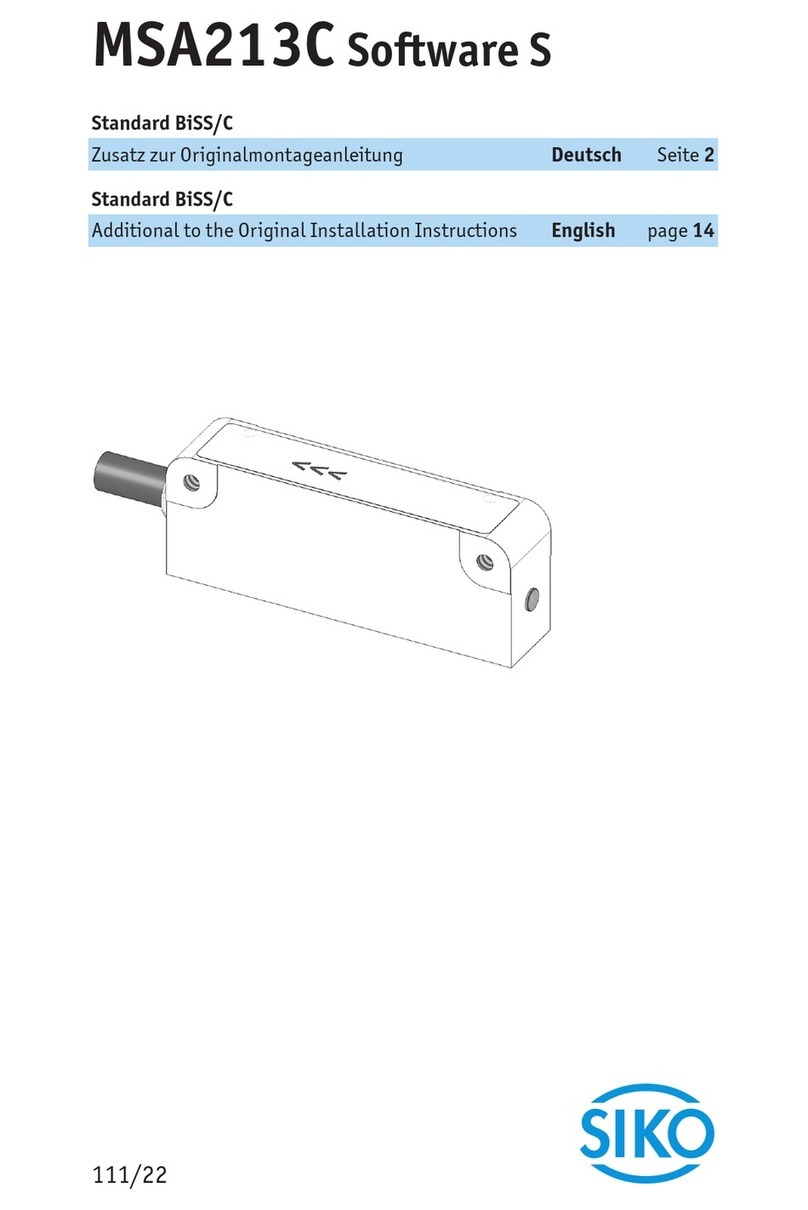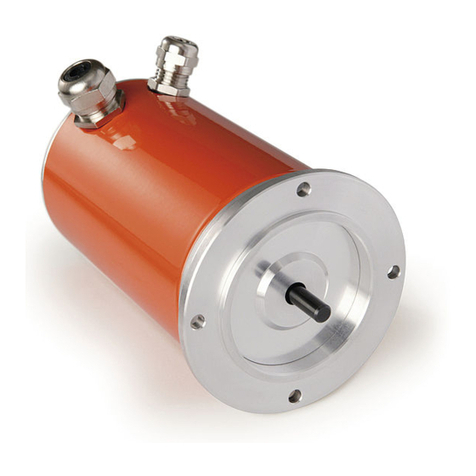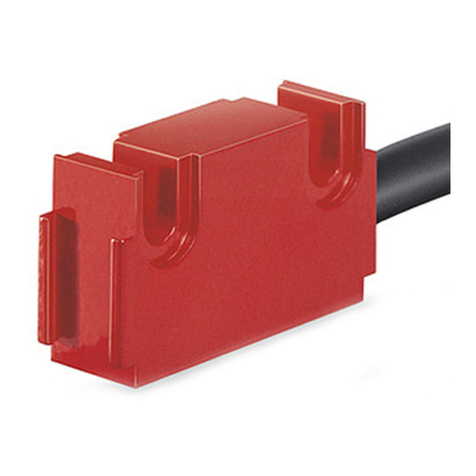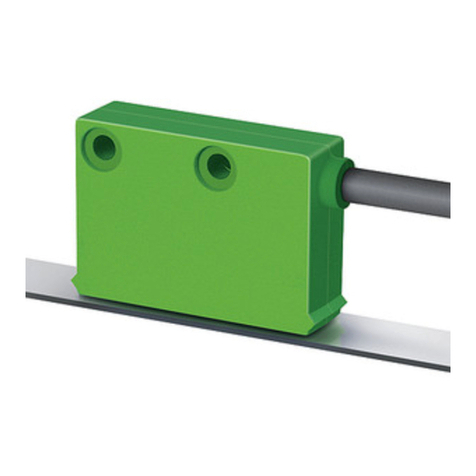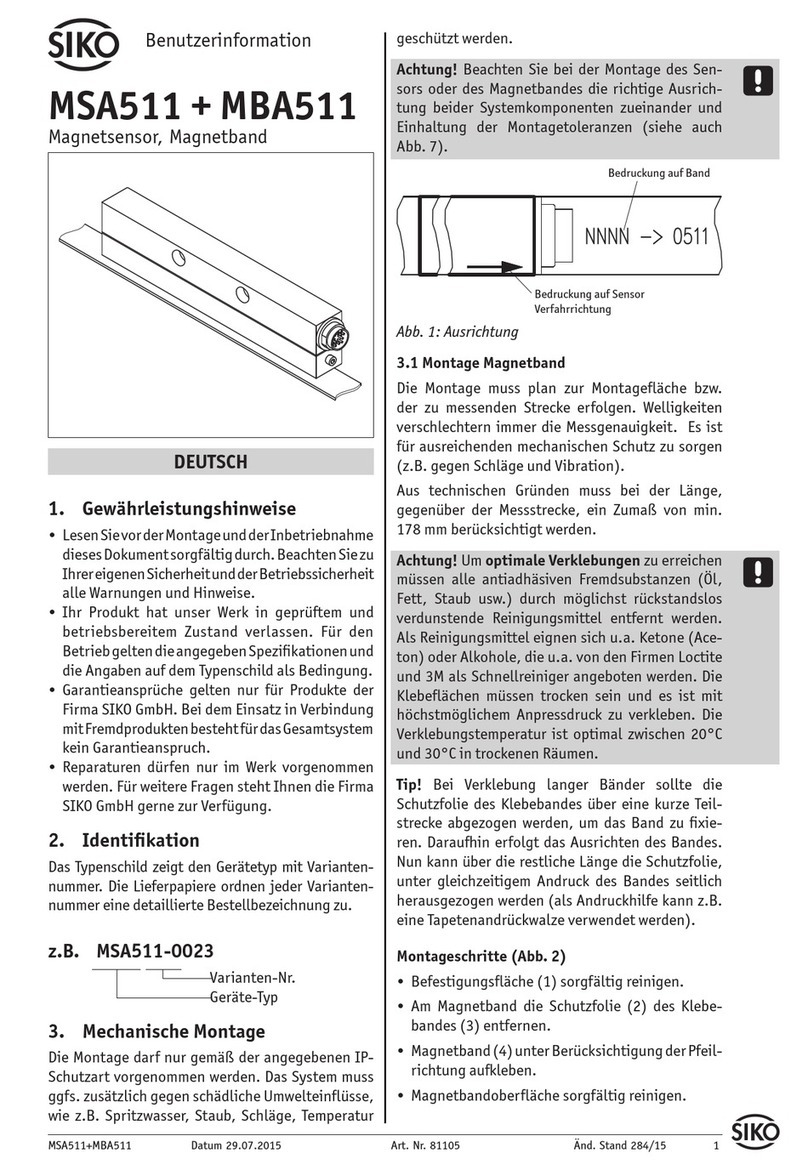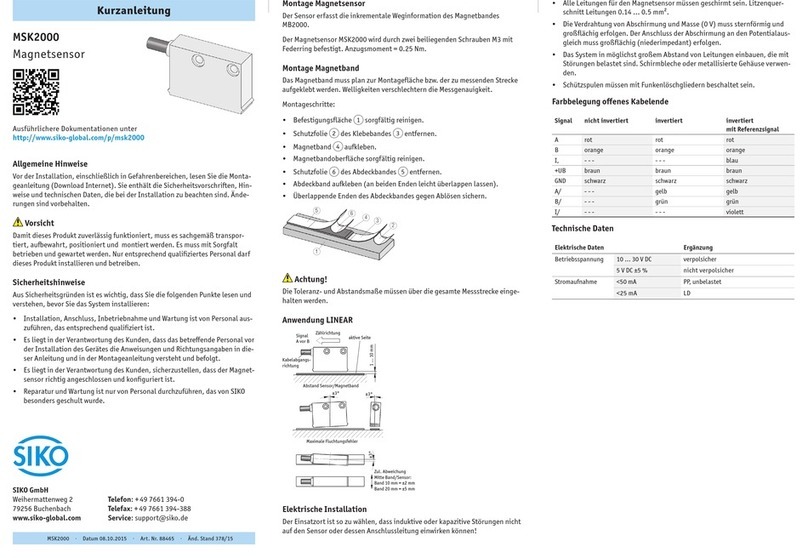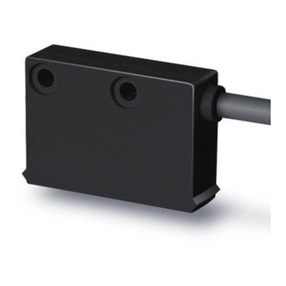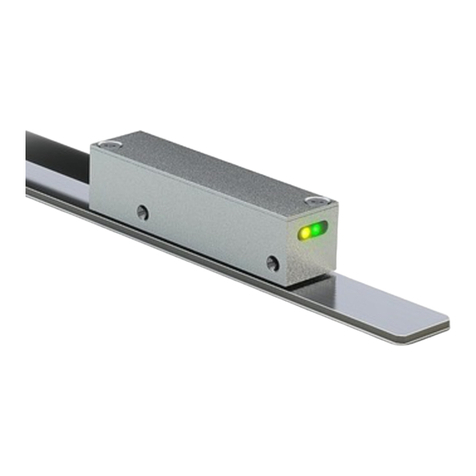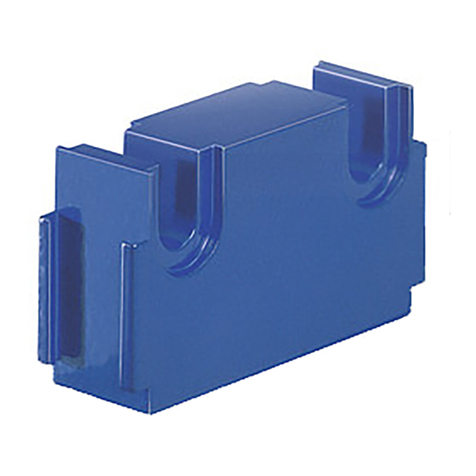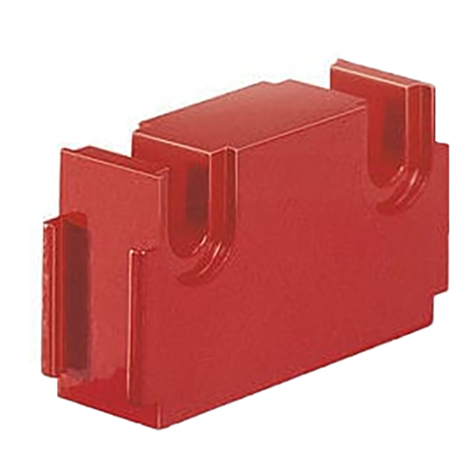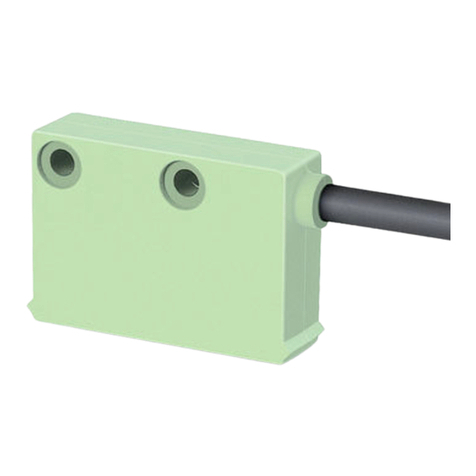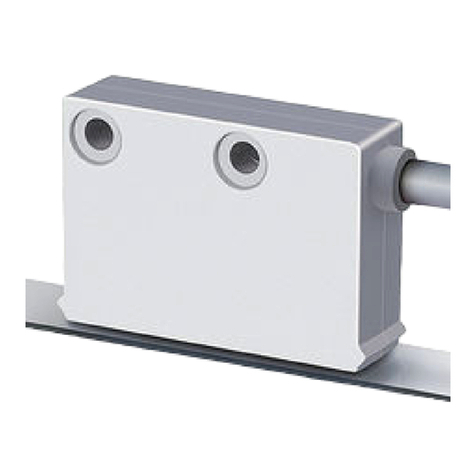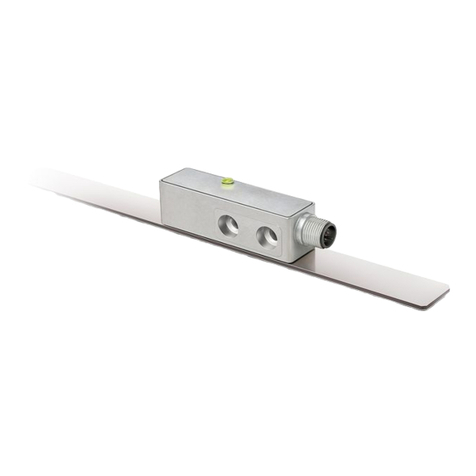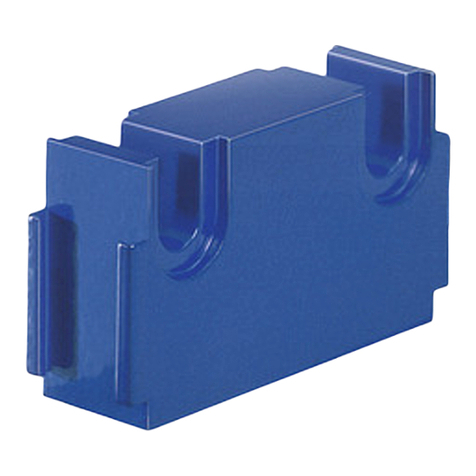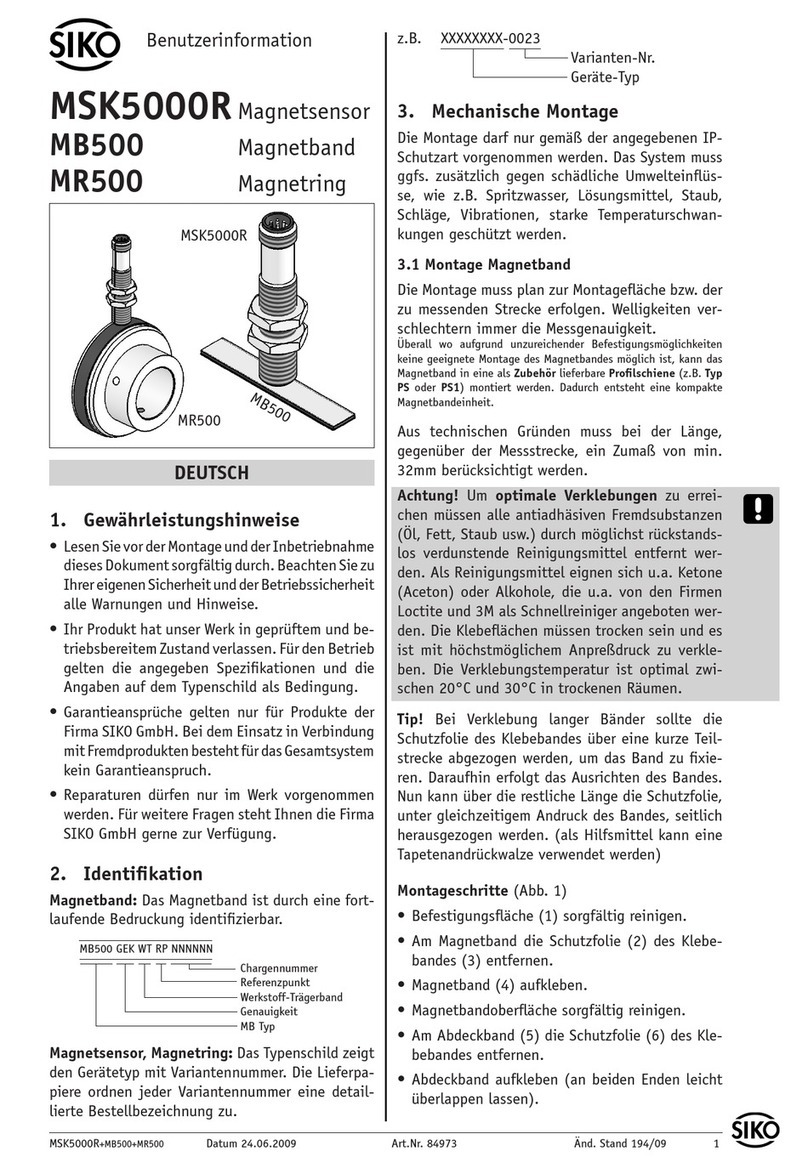Siko MB500 Operation manual

MSK5000+MB500+MR500 Datum 08.08.2011 Art.Nr. 83109 Änd. Stand 280/11 1
MSK5000
MB500
MR500
DEUTSCH
Sensordarstellungen sind exemplarisch und gül-
tig für alle Bauformen, sofern nicht gesondert be-
schrieben.
1. Gewährleistungshinweise
• LesenSievorderMontageundderInbetriebnahme
diesesDokumentsorgfältigdurch.BeachtenSiezu
IhrereigenenSicherheitundderBetriebssicherheit
alle Warnungen und Hinweise.
• Ihr Produkt hat unser Werk in geprüftem und
betriebsbereitem Zustand verlassen. Für den
BetriebgeltendieangegebenSpezifikationenund
die Angaben auf dem Typenschild als Bedingung.
• Garantieansprüche gelten nur für Produkte der
Firma SIKO GmbH. Bei dem Einsatz in Verbindung
mitFremdproduktenbestehtfürdasGesamtsystem
kein Garantieanspruch.
• Reparaturen dürfen nur im Werk vorgenommen
werden. Für weitere Fragen steht Ihnen die Firma
SIKO GmbH gerne zur Verfügung.
2. Identifikation
Magnetband: Das Magnetband ist durch eine fort-
laufende Bedruckung identifizierbar.
Magnetsensor, Magnetring: Das Typenschild zeigt
den Gerätetyp mit Variantennummer. Die Lieferpa-
piere ordnen jeder Variantennummer eine detail-
lierte Bestellbezeichnung zu.
z.B. XXXXXXX-0023
Varianten-Nr.
Geräte-Typ
3. Mechanische Montage
Die Montage darf nur gemäß der angegebenen IP-
Schutzart vorgenommen werden. Das System muss
ggfs. zusätzlich gegen schädliche Umwelteinflüsse,
wie z.B. Spritzwasser, Lösungsmittel, Staub, Schlä-
ge, Vibrationen, starke Temperaturschwankungen
geschützt werden.
3.1 Montage Magnetband
Die Montage muss plan zur Montagefläche bzw. der
zu messenden Strecke erfolgen. Welligkeiten ver-
schlechtern immer die Messgenauigkeit.
Überall wo aufgrund unzureichender Befestigungsmöglichkeiten
keine geeignete Montage des Magnetbandes möglich ist, kann das
Magnetband in eine als Zubehör lieferbare Profilschiene (z.B. Typ
PS oder PS1) montiert werden. Dadurch entsteht eine kompakte Ma-
gnetbandeinheit.
Aus technischen Gründen muss bei der Länge,
gegenüber der Messstrecke, ein Zumaß von min.
56mm berücksichtigt werden.
Achtung! Um optimale Verklebungen zu erreichen
müssen alle antiadhäsiven Fremdsubstanzen (Öl,
Fett, Staub usw.) durch möglichst rückstandslos
verdunstende Reinigungsmittel entfernt werden.
Als Reinigungsmittel eignen sich u.a. Ketone (Ace-
ton) oder Alkohole, die u.a. von den Firmen Loctite
und 3M als Schnellreiniger angeboten werden. Die
Klebeflächen müssen trocken sein und es ist mit
höchstmöglichem Anpreßdruck zu verkleben. Die
Verklebungstemperatur ist optimal zwischen 20°C
und 30°C in trockenen Räumen.
Tip! Bei Verklebung langer Bänder sollte die
Schutzfolie des Klebebandes über eine kurze Teil-
strecke abgezogen werden, um das Band zu fixie-
ren. Daraufhin erfolgt das Ausrichten des Bandes.
Nun kann über die restliche Länge die Schutzfolie,
unter gleichzeitigem Andruck des Bandes, seitlich
herausgezogen werden (als Hilfsmittel kann eine
Tapetenandrückwalze verwendet werden).
Montageschritte (Abb. 1)
• Befestigungsfläche (1) sorgfältig reinigen.
• Am Magnetband die Schutzfolie (2) des Klebe-
bandes (3) entfernen.
• Magnetband (4) aufkleben.
Benutzerinformation
MSK5000 Magnetsensor
MB500 Magnetband
MR500 Magnetring
Chargennummer
Referenzpunkt
Werksto-Trägerband
Genauigkeit
MB Typ
MBxxxx GEK WT RP NNNNNN

2 MSK5000+MB500+MR500 Datum 08.08.2011 Art.Nr. 83109 Änd. Stand 280/11
Abb. 1: Montage Magnetband
Abb. 2 Abb. 3
Abb. 4 Abb. 5
0.1mm ... 2.0mm
ohne Referenzpunkt
0.1mm ... 1.5mm mit
Referenzpunkt
Abstand Sensor/Magnetband
Maximale Fluchtungsfehler
< 1°
< 3°
< 3°
aktive
Seite
Kabelabgangs-
richtung
Verfahrrichtung
Signal
A vor B
Referenzpunktlage zur Magnetbandbe-
druckung
Zul. Abweichung
Mitte Band/Sensor:
ohne Ref. ±2mm
mit Ref. ±0.5mm
MBxxxx GEK WT RP NNNNNN
• Der Magnetring MR500 muss möglichst kraft-
und spannungsfrei montiert werden. Eventuell
erforderliche Belastungen sind am Metallflansch
aufzubringen. Schläge auf den Magnetring sind
zu vermeiden.
• Ein Wellenfreistich entsprechend Abb. 7 wird
empfohlen.
3.3 Montage Magnetsensor MSK5000
Der Magnetsensor MSK5000 kann durch Verwen-
dung von 2 Schrauben M3 über die Langlöcher be-
festigt werden. Es wird empfohlen die beiliegenden
Befestigungsschrauben und Federringe zu verwen-
den (Anzugsmoment Bauform K=0,25Nm, Bauform
M+AM=1Nm).
• Kabel sind so zu verlegen, dass keine Beschädi-
gungsgefahr besteht. Zugentlastung und wenn
nötigSchleppketteoderSchutzschlauchvorsehen.
• Auf richtige Ausrichtung bezüglich der Zähl-
richtung achten (Abb. 6+7). Dies ist unerheblich
falls sich die Zählrichtung in der elektronischen
Auswertung umkehren läßt (wie z.B. bei den
Magnetbandanzeigen von SIKO).
Achtung! Die Toleranz- und Abstandsmaße müssen
über die gesamte Messstrecke eingehalten werden.
Anwendung LINEAR MSK5000 mit MB500:
Anwendung RADIAL MSK5000 mit MR500:
3.2 Montage Magnetring MR500
Nach dem Aufschieben des Magnetringes auf die
Welle, wird durch Anziehen des Gewindestiftes M6
der MR500 mit der Welle verbunden.
• Zwischen Welle und dem MR500 ist ein Schiebesitz
vorzusehen.
• Magnetbandoberfläche sorgfältig reinigen.
• Am Abdeckband (5) die Schutzfolie (6) des Klebe-
bandes entfernen.
• Abdeckband aufkleben (an beiden Enden leicht
überlappen lassen).
• DieüberlappendenEndendesAbdeckbandesgegen
Ablösen sichern.
Achtung! Die Beeinflussung durch magnetische
Felder ist zu vermeiden. Insbesondere dürfen keine
Magnetfelder (z.B. Haftmagnete oder andere Dau-
ermagnete) in direkten Kontakt mit dem Magnet-
band geraten. In stromlosem Zustand werden Be-
wegungen oder Verstellungen des Magnetsensors
von der Folgeelektronik nicht erkannt und erfasst.
Montagebeispiele
Die einfache Montageart, durch angeschrägtes
Schutzband (Abb. 2), ist nur in sehr geschützter
Umgebung zu empfehlen. Bei ungeschützer Um-
gebung besteht Abschälgefahr. In solchen Fällen
sind Montagearten, wie in Abb. 3 und 4 gezeigt,
geeigneter.
Den optimalen Schutz bietet die Montage in einer
Nut (Abb. 5), die so tief sein sollte, dass das Ma-
gnetband vollständig darin eingebettet werden
kann.

MSK5000+MB500+MR500 Datum 08.08.2011 Art.Nr. 83109 Änd. Stand 280/11 3
Abb. 6: Definition der Zählrichtung mit Magnetband
und Montage Sensor/Magnetband, Abstandsmaße,
Toleranzen
Lage Ref.Punkt R=entspr. Lieferpapiere
Lage Ref.Punkt E=entspr. Lieferpapiere
min. 0,05m
Symbolische Dar-
stellung der Pole Einmaliger Referenzpunkt
Referenzpunkt periodisch
Abb.7: Definition der Zählrichtung mit Magnetring
und Montage Sensor / Magnetring, Abstandsmaße,
Toleranzen
< 3°
< 3° Freistich an
der Vollwel-
le für Gewin-
destift wird
empfohlen
Signal
A vor B Drehrichtung Magnetring
0.1mm ... 2.0mm ohne Referenzpunkt
0.1mm ... 1.5mm mit Referenzpunkt
Referenz-
punkt
Kabelabgangsrichtung
Zul. Abweichung
Mitte Band/Sensor:
ohne Ref. ±2mm
mit Ref. ±0.5mm
4. Elektrischer Anschluss
rung und Verdrahtung können Störeinflüsse (z.B.
von Schaltnetzteilen, Motoren, getakteten Reglern
oder Schützen) vermindert werden.
Erforderliche Maßnahmen
• Nur geschirmtes Kabel verwenden. Den Kabel-
schirm beidseitig auflegen. Litzenquerschnitt der
Leitungen min. 0,14mm²; max. 0,5mm².
• Die Verdrahtung von Abschirmung und Masse
(0V) muss sternförmig und großflächig erfolgen.
Der Anschluss der Abschirmung an den Potenti-
alausgleich muss großflächig (niederimpedant)
erfolgen.
• DasSystemmussinmöglichstgroßemAbstandvon
Leitungen eingebaut werden, die mit Störungen
belastet sind;ggfs. sind zusätzliche Maßnahmen
wie Schirmbleche oder metallisierte Gehäuse
vorzusehen. Leitungsführungen parallel zu Ener-
gieleitungen vermeiden.
• Schützspulen müssen mit Funkenlöschgliedern
beschaltet sein.
Spannungsversorgung
Die Spannungswerte sind abhängig von der Sen-
sorausführung und sind den Lieferpapieren sowie
dem Typenschild zu entnehmen.
z.B.: 6,5VDC ... 30VDC
Achtung! Die maximale Länge des Anschlusskabels
zwischen Sensor und Nachfolgeelektronik beach-
ten.
4.1 Anschlusshinweis nach RS422 Norm
Es ist darauf zu achten, dass die Kanäle mit einem
Abschlusswiderstand von 120 Ohm abgeschlossen
werden.
• Verdrahtungsarbeiten dürfen nur spannungslos
erfolgen!
• Vor dem Einschalten sind alle Leitungsanschlüsse
und Steckverbindungen zu überprüfen.
Hinweise zur Störsicherheit
Alle Anschlüsse sind gegen äußere Störeinflüsse
geschützt. Der Einsatzort ist aber so zu wählen,
dass induktive oder kapazitive Störungen nicht
auf den Sensor oder dessen Anschlussleitung
einwirken können! Durch geeignete Kabelfüh-

4 MSK5000+MB500+MR500 Datum 08.08.2011 Art.Nr. 83109 Änd. Stand 280/11
Abb. 8: Anschluss E1
so kurz wie
möglich
Schirm
Ansichtseite =
Steckseite
Stiftkontakt
Ansichtseite =
Steckseite
Stiftkontakt
Abb. 9: Montage Anschlussart E6
Schirm
Buchsenteil
Stiftteil
Schirm
Ansichtseite = Steckseite
Stiftkontakt
4.2 Anschlussarten
E1: Anschluss mit oenen Kabelenden.
Achtung! Verzinnte Litzen dürfen nicht in Verbin-
dung mit Schraubklemmverbindungen eingesetzt
werden.
Signal invertiert invertiert mit
Indexsignal
Arot rot
B orange orange
I, R - - - blau
+UB braun braun
GND schwarz schwarz
/A gelb gelb
/B grün grün
/I, /R - - - violett
1. Ummantelung entfernen.
2. Schirm auftrennen und verdrillen.
3. Litzen ca. 5mm abisolieren und verdrillen.
4. Aderendhülsen aufquetschen.
stülpen, zusammendrücken und auf Pos. 3
stecken. Schlitz und Nut (Pos. 3 und 4) müssen
deckungsgleich sein.
7. Pos. 6 an Pos. 5 drücken, überstehenden Schirm
abschneiden.
8. Pos. 2 und 7 aufschieben und mittels Montage-
werkzeug Pos. 11 verschrauben.
9. Pos.8inPos.9stecken,beidesinPos.7schieben.
10.Pos. 10 mit Pos. 7 verschrauben.
11.Pos. 1 in Pos. 2 schieben.
E6: Anschluss mit Kupplungsstecker und Kupp-
lungsdose. Steckermontage entsprechend Abb. 9.
Signal invertiert invertiert mit
Indexsignal
A Pin 1 Pin 1
B 2 2
I, R - - - 3
+UB 4 4
GND 5 5
/A 6 6
/B 7 7
/I, /R - - - 8
- - - 3 - - -
1. Pos. 6 ... 10 über Kabelmantel schieben.
2. Kabel abisolieren.
3. Schirm umlegen.
4. Pos. 5 auf Litzen schieben.
5. Litzen an Pos. 3 löten (entspr. Anschlussplan).
6. Abstandhülse Pos. 4 aufweiten und über Litzen
E7: Anschluss mit Kupplungsstecker.
Signal invertiert invertiert mit
Indexsignal
A Pin 1 Pin 1
B 2 2
I, R - - - 3
+UB 4 4
GND 5 5
/A 6 6
/B 7 7
/I, /R - - - 8
- - - 3 - - -
E8: Anschluss mit 9-poligem D-SUB Stecker.
Signal invertiert invertiert mit Indexsignal
A Pin 1 Pin 1
B 2 2
I, R - - - 3
+UB 4 4
GND 5 5

MSK5000+MB500+MR500 Datum 08.08.2011 Art.Nr. 83109 Änd. Stand 280/11 5
A B I/R Power
Metallgehäuse
Power A B I/R
Kunststogehäuse
Ansichtseite =
Steckseite
Stiftkontakt
V max. =
(in mm/s)
Auflösung in mm
Pulsabstand in s x 0.8
V = 0,01
0,0000025 x 0.8 = 3200mm/s
Signal invertiert invertiert mit Indexsignal
/A 6 6
/B 7 7
/I, /R - - - 8
- - - 3, 8, 9 9
E8S: Anschluss mit 9-poligem D-SUB Stecker.
Signal invertiert invertiert mit Indexsignal
A Pin 1 Pin 1
B 3 3
I, R - - - 5
+UB 8 8
GND 7,9 * 7,9 *
/A 2 2
/B 4 4
/I, /R - - - 6
- - - 5,6 - - -
Schirm # #
* gebrückt
# Schirm auf Gehäuse
E14X: Anschluss mit 9-poligem Stecker.
Signal invertiert invertiert mit
Indexsignal
A Pin 1 Pin 1
B 2 2
I, R - - - 3
+UB 8 8
GND 7 7
/A 4 4
/B 5 5
/I, /R - - - 6
- - - 3,6 - - -
Schirm 9 9
5. Inbetriebnahme
Nach ordnungsgemäßer Montage und Verdrah-
tung kann das Messsystem durch Einschalten der
Versorgungsspannung in Betrieb genommen wer-
den. Das Gerät initialisiert sich selbstständig nach
dem Einschalten. Die "Power"-Leuchtdiode (grün)
im Sensorgehäuse leuchtet. Beim Verfahren des
Magnetsensors über das Magnetband blinken die
Leuchtdioden A, B und I/R (rot) entsprechend auf.
Das Messsystem MSK5000/MB500 ist Bestandteil
eines inkrementalen Messsystem, dass zur absolu-
ten Messung an einer definierten Stelle (Referenz-
punkt) referenziert werden muss. Dazu muss das
Referenzsignal mit dem Signal eines Referenzwert-
gebers (z.B. Näherungsschalter) verknüpft werden.
6. Verfahrgeschwindigkeiten (m/s)
Formel zur Berechnung der Verfahrgeschwindig-
keit:
Beispiel:
Auflösung: 0,01mm
Pulsabstand: 2,5µs
Auflösung in mm
Pulsabstand
(µs)
Zählfrequenz
(kHz)
0,001 0,005 0,010 0,025 0,050 0,100
Verfahrgeschwindigkeit in m/s
0,01 0,06 0,12 0,30 0,61 1,21 66,00 3,79
0,03 0,13 0,25 0,63 1,25 2,50 32,00 7,81
0,05 0,25 0,50 1,25 2,50 5,00 16,00 15,63
0,10 0,50 1,00 2,50 5,00 10,00 8,00 31,25
0,20 1,00 2,00 5,00 10,00 20,00 4,00 62,50
0,32 1,60 3,20 8,00 16,00 25,00 2,50 100,00
0,80 4,00 8,00 20,00 25,00 25,00 1,00 250,00
1,60 8,00 16,00 25,00 25,00 25,00 0,50 500,00
3,20 16,00 25,00 25,00 25,00 25,00 0,25 1000,00
4,00 20,00 25,00 25,00 25,00 25,00 0,20 1250,00
7. Ausgangssignale
Die Auswerteelektronik setzt die magnetischen
Längeninformationen des Magnetsensors in inkre-
mentale Ausgangssignale um. Die Ausgabe der Si-
gnale erfolgt geschwindigkeitsproportional.

6 MSK5000+MB500+MR500 Datum 08.08.2011 Art.Nr. 83109 Änd. Stand 280/11
Es ist zu beachten, dass im Stillstand Impulse von
der Breite des eingestellten Pulsabstandes auf-
treten können (bedingt durch das interne Interpo-
lationsverfahren).
Achtung! Bei der Dimensionierung der Nachfolgee-
lektronik ist zu beachten, dass diese für den einge-
stellten Pulsabstand bzw. Zählfrequenz ausgelegt
ist.
Signalfolge
Hinweis: Die Lage des Index- bzw. Referenzsignals
I+R zu den Signalen A und B ist nicht definiert und
kann von der Zeichnung abweichen.
Hinweis: Bei Index-/Referenzsignalbreite von 4
Inkrementen (= 360°), ist der Index/Referenz erst
nach dem 5. Zählschritt (Inkrement) auswertbar.
Nach dem Einschalten der Betriebsspannung ent-
sprechende Verzögerung berücksichtigen.
8. Wartung
Die Oberfläche des Magnetbandes ist bei starker
Verschmutzung durch Staub, Späne, Feuchtigkeit
usw., von Zeit zu Zeit mit einem weichen Lappen zu
reinigen.
9. Fehlerbehandlung
Typische Fehler, die bei Anbau und Betrieb auftre-
ten:
• Das Magnetband wurde falsch montiert / aktive
Seite nach unten (siehe Kapitel 3.1).
• Zum Schutz des Magnetbandes wurde nicht das
mitgelieferteAbdeckbandverwendet.DasAbdeck-
band muss nicht magnetisierbar sein.
• DerSensoristnicht,odernichtkorrektangeschlos-
sen (Pinbelegung Kapitel 4.2).
• Die Abstandstoleranz zwischen Sensor und Ma-
gnetband/Magnetring wurde nicht eingehalten
(beim Band über die gesamte Messstrecke!), der
Sensor streift auf dem Magnetring (Abb. 6+7).
• Kabelunterbrechung / Abtrennung durch scharfe
Kanten / Quetschung.
• Der Sensor ist mit der aktiven Seite vom Band
abgewandt montiert (Abb. 6+7).
• Der Sensor wurde nicht entsprechend Abb. 6+7
ausgerichtet.

MSK5000+MB500+MR500 Datum 08.08.2011 Art.Nr. 83109 Änd. Stand 280/11 7
MSK5000
MB500
MR500
ENGLISH
Exemplary sensor illustrations are valid for all sen-
sor types unless described separately.
1. Warranty information
• In order to carry out installation correctly, we
strongly recommend this document is read very
carefully. This will ensure your own safety and the
operating reliability of the device.
• Yourdevicehasbeenqualitycontrolled,testedand
is ready for use. Please observe all warnings and
information which are marked either directly on
the device or specified in this document.
• Warranty canonly beclaimed for componentssup-
pliedbySIKOGmbH.If the system is used together
with other products, there is no warranty for the
complete system.
• Repairs should be carried out only at our works.
If any information is missing or unclear, please
contact the SIKO sales sta.
2. Identification
Magnetic strip: identification by printing on the strip.
Magnetic sensor, magnetic ring: Please check the
particular type of unit and type number from the
identification plate. Type number and the corre-
sponding version are indicated in the delivery do-
cumentation.
e.g. XXXXXXX-0023
version number
type of unit
3. Installation
For mounting, the degree of protection specified
must be observed. If necessary, protect the unit
against environmental influences such as sprayed
water, dust, knocks, extreme temperatures.
3.1 Mounting the magnetic strip
The mounting surface / measuring track must be
flat. Buckles or bumps will lead to measuring inac-
curacies.
For applications which do not allow properly glueing of the magnetic
strip, it can be inserted into a profile rail (accessory) - e.g. rail type
PS or PS1 thus forming a compact mounting unit.
For technical reasons the strip should be min.
56mm longer than the actual measuring distance.
Attention! To guarantee optimal adhesion oil, gre-
ase dust etc. must be removed by using cleansing
agents which evaporate without leaving residues.
Suitable cleansing agents are e.g. ketones (ace-
tone) or alcohols; Messrs. Loctite and 3M can both
supply such cleansing liquid. Make sure that the
surface to be glued is dry and apply the strip with
maximum pressure. Glueing should preferably be
undertaken at temperatures between 20°C to 30°C
and in dry atmosphere.
Advice! When applying long pieces of magnetic
strip do not immediately remove the complete
protective foil, but rather peel back a short part
from the end sucient to fix the strip. Now align
the strip. As the protective strip is then peeled back
and out press the tape firmly onto the mounting
surface. A wall paper roller wheel could be used to
assist in applying pressure onto the magnetic strip
when fixing it in position.
Mounting steps (see fig. 1)
• Clean mounting surface (1) carefully.
• Remove protective foil (2) from the adhesive side
of the magnetic strip (3).
• Stick down the magnetic strip (4).
• Clean surface of magnetic strip carefully.
• Remove protective foil (6) from adhesive tape on
the cover strip (5).
User Information
MSK5000 Magnetic sensor
MB500 Magnetic strip
MR500 Magnetic ring
batch number
reference point
carrier strip
accuracy
MB type
MBxxxx GEK WT RP NNNNNN

8 MSK5000+MB500+MR500 Datum 08.08.2011 Art.Nr. 83109 Änd. Stand 280/11
Fig. 1: Mounting of the magnetic strip
Fig. 2 Fig. 3
Fig. 4 Fig. 5
0.1mm ... 2.0mm wit-
hout reference point
0.1mm ... 1.5mm with
reference point
Gap sensor/magnetic strip
Maximum alignment error
active side
Direction of
outgoing cable
Travel direction
Signal
A before B
Position of the reference point relating
to the marking on the magnetic strip.
Admissable deviatoion
middle of tape/sensor:
without ref. point ±2mm
with ref. point ±0.5mm
< 1°
< 3°
< 3°
MBxxxx GEK WT RP NNNNNN
• Fixcoverstrip(bothendsshouldslightlyoverlap).
• Also fix cover strip's ends to avoid unintentional
peeling.
3.3 Mounting of the magnetic sensor MSK5000
The magnetic sensor MSK5000 can be fastened by
using two bolts M3 over the elongated holes. We
recommend to use the enclosed fixing screws and
washer springs (fastening torque design K=0,25Nm,
design M+AM=1Nm).
• Cables should be layed in such a way that there is
no danger of damaging. Provide tension relief and
drag chain or casing, if necessary.
• Observe the correct alignment with regard to
the counting direction (fig. 6 and 7). This does
notapply if the counting direction can be reversed
in the electronic interpretation (e.g. in SIKO's
magnetic-strip displays).
Attention! The tolerance and gap measures must
be observed over the whole measuring length.
LINEAR application MSK5000 with MB500:
Attention! Do not expose the system to magnetic
fields. Any direct contact of the magnetic strip with
magnetic fields (e.g. adhesive magnets or other
permanent magnets) is to be avoided. Sensor mo-
vements during power loss are not captured by the
follower electronics.
Mounting examples
Mounting with chamfered ends (fig. 2) is not re-
commended unless the strip is installed in a safe
and protected place without environmental influ-
ences. In less protected mounting places the strip
may peel. There we recommend mounting accord.
to fig. 3 and 4.
Mounting in a groove (fig. 5) best protects the ma-
gnetic strip. The groove should be deep enough to
totally embed the magnetic strip.
3.2 Mounting of the magnetic ring MR500
Slide magnetic ring MR500 onto the shaft and then
tighten grub screw M6 to fix it to the shaft.
• Ensure sliding fit between shaft and MR500.
• Mount MR500 without force and without strain.
Possible forces should go to the metal flange.
Avoid knocks on the magnetic ring.
• Provide for a relief groove in the solid shaft (see
fig. 7).

MSK5000+MB500+MR500 Datum 08.08.2011 Art.Nr. 83109 Änd. Stand 280/11 9
Fig. 6: Definition of the counting direction with ma-
gnetic strip and assemblage sensor/magnetic ring,
gap measure, tolerances
Position of the reference point R = as
stated in the delivery documentation
Position of the reference point E = as stated
in the delivery documentation; min. 0,05m
Magnetic poles -
schema Unique reference point
Periodical reference point
Fig.7: Definition of the counting direction with ma-
gnetic ring and assemblage sensor/magnetic ring,
gap measure, tolerances
Undercut
at the solid
shaft for
tread plug
is recom-
mended
Signal
A before B Direction of rotation
of magnetic ring
0.1mm ... 2.0mm without reference point
0.1mm ... 1.5mm with reference point
reference
point
Direction of outgoing cable
Admissable deviatoion
middle of tape/sensor:
without ref. point ±2mm
with ref. point ±0.5mm
< 3°
< 3°
RADIAL application MSK5000 with MR500:
ference caused by SMPS, motors, cyclic controls and
contactors).
Necessary measures:
• Only screened cable should be used. Wire cross
section is to be at least 0,14mm², max. 0,5mm².
• Wiring to the screen and ground (0V) must be se-
curedtoagoodpoint.Ensurethattheconnectionof
thescreenandearthismadetoalargesurfacearea
with a sound connection to minimise impedance.
• The system should be positioned well away from
cableswithinterference;if necessaryaprotective
screen or metal housing must be provided. The
running of wiring parallel to the mains supply
should be avoided.
• Contactor coils must be linked with spark sup-
pression.
Supply voltage
The voltages depend on the sensor designs; they
are to be taken from the delivery documentation
and the identification plate.
e.g.: 6,5VDC ... 30VDC
Attention! When connecting sensor and follower
electronics, please do not exceed the max. admis-
sable cable length.
4.1 Connection note acc. to RS422 standard
Please provide the channels with a 120 Ohm termi-
nating resistor.
4. Electrical connection
• Wiring must only be carried out with power o!
• Check all lines and connections before switching
on the equipment!
Interference and distortion
All connections are protected against the eects
of interference. The location should be selected
to ensure that no capacitive or inductive inter-
ferences can aect the sensor or the connection
lines! Suitable wiring layout and choice of cable
can minimise the eects of interference (e.g. inter-
4.2 Connection type
E1: Flying leads.
Attention! Tinned strands must not used in combi-
nation with screw/clamp connections.

10 MSK5000+MB500+MR500 Datum 08.08.2011 Art.Nr. 83109 Änd. Stand 280/11
Fig. 8: Connection type E1
as short as
possible
screening
viewing side =
plug-in side
plug pin
viewing side =
plug-in side
plug pin
viewing side = plug-in side
plug pin
Fig. 9: Coupler socket E6
screening
socket
pin
screening
using appropriate tool.
9. Push part 8 into part 9 and slide both parts
into part 7.
10.Screw parts 10 and 7 together.
11.Push part 1 into part 2.
Signal inverted inverted with
reference signal
Ared red
B orange orange
I, R - - - blue
+UB brown brown
GND black black
/A yellow yellow
/B green green
/I, /R - - - violet
1. Remove cable coating.
2. Open screening and twist it.
3. Strip stranded wires to a length of 5mm and
twist them.
4. Pinch stranded wires.
E6: Connection with mit coupler plug and coupler
socket. Plug mounting according to fig. 9.
Signal inverted inverted with
reference signal
A Pin 1 Pin 1
B 2 2
I, R - - - 3
+UB 4 4
GND 5 5
/A 6 6
/B 7 7
/I, /R - - - 8
- - - 3 - - -
1. Slip parts 6 to 10 over outer cable.
2. Strip cable.
3. Turn down screening.
4. Push part 5 onto ferrules.
5. Solder wires to part 3 (according connection
diagram).
6. Open spacer (part 4) and put it over ferrules,
squeeze and push it onto part 3. Slot and keyway
of parts 3 and 4 must align.
7. Press parts 6 and 5 together; cut prodruding
screening.
8. Push parts 2 and 7 together and screw part 11
E7: Connection with coupler plug.
Signal inverted inverted with
reference signal
A Pin 1 Pin 1
B 2 2
I, R - - - 3
+UB 4 4
GND 5 5
/A 6 6
/B 7 7
/I, /R - - - 8
- - - 3 - - -
E8: Connection with 9-pole D-SUB plug.
Signal inverted inverted with reference signal
A Pin 1 Pin 1
B 2 2
I, R - - - 3
+UB 4 4
GND 5 5
/A 6 6
/B 7 7
/I, /R - - - 8
- - - 3, 8, 9 9

MSK5000+MB500+MR500 Datum 08.08.2011 Art.Nr. 83109 Änd. Stand 280/11 11
A B I/R Power
metal housing
Power A B I/R
plastic housing
viewing side =
plug-in side
plug pin
V max. =
(in mm/s)
Resolution mm
Pulse interval s x 0.8
The measuring system MSK5000/MB500 is a com-
ponent of an incremental measuring system which
must be referenced at a defined position (reference
point) for absolute measurement. For this purpose,
the reference signal must be linked to the signal of
a reference value encoder (e.g. proximity switch).
6. Travel speeds (m/s)
Formula for calculating the travel speed:
V = 0,01
0,0000025 x 0.8 = 3200mm/s
E8S: Connection with 9-pole D-SUB plug.
Signal inverted inverted with reference
signal
A Pin 1 Pin 1
B 3 3
I, R - - - 5
+UB 8 8
GND 7,9 * 7,9 *
/A 2 2
/B 4 4
/I, /R - - - 6
- - - 5,6 - - -
shilding # #
* jumpered
# shielding on housing
E14X: Connection with 9-pole plug.
Signal inverted inverted with
reference signal
A Pin 1 Pin 1
B 2 2
I, R - - - 3
+UB 8 8
GND 7 7
/A 4 4
/B 5 5
/I, /R - - - 6
- - - 3,6 - - -
shielding 9 9
5. Commissioning
Following proper installation and wiring, the
measuring system can be commissioned by
switching on the supply voltage. After switching
on, the device initializes itself independently. The
"power" LED (green) in the sensor housing lights
up. While the magnetic sensor travels over the ma-
gnetic strip, the LEDs A, B and I/R (red) are lighting
accordingly.
Example:
Resolution: 0,01mm
Pulse interval: 2,5µs
Resolution mm
Pulse inter-
val (µs)
Counting
frequency
(kHz)
0,001 0,005 0,010 0,025 0,050 0,100
Travel speed m/s
0,01 0,06 0,12 0,30 0,61 1,21 66,00 3,79
0,03 0,13 0,25 0,63 1,25 2,50 32,00 7,81
0,05 0,25 0,50 1,25 2,50 5,00 16,00 15,63
0,10 0,50 1,00 2,50 5,00 10,00 8,00 31,25
0,20 1,00 2,00 5,00 10,00 20,00 4,00 62,50
0,32 1,60 3,20 8,00 16,00 25,00 2,50 100,00
0,80 4,00 8,00 20,00 25,00 25,00 1,00 250,00
1,60 8,00 16,00 25,00 25,00 25,00 0,50 500,00
3,20 16,00 25,00 25,00 25,00 25,00 0,25 1000,00
4,00 20,00 25,00 25,00 25,00 25,00 0,20 1250,00
7. Output signals
The translation module translates the length
information of the magnetic sensor into incre-
mental output signals with real-time processing of
the output signals.

12 MSK5000+MB500+MR500 Datum 08.08.2011 Art.Nr. 83109 Änd. Stand 280/11
SIKO GmbH
Werk/Factory:
Weihermattenweg 2
79256 Buchenbach-Unteribental
Postanschrift / Postal address:
Postfach 1106
79195 Kirchzarten
Telefon/Phone +49 7661 394-0
Telefax/Fax +49 7661 394-388
E-Mail info@siko.de
Internet www.siko.de
Service suppor[email protected]
Please note that pulses having the width of the
pulse interval set can occur at standstill of the
device (caused by the internal interpolation me-
thod).
Attention! When dimensioning the follow-on elec-
tronics please take care that it is adjusted to the set
pulse interval or counting frequency, respectively.
Signal sequence
Note: The position of the index or reference sig-nal
I+R, respectively, with respect to signals A and B is
not defined and can deviate from the drawing.
Note: With a 4-increment wide (= 360°) index/
reference signal, index/reference signal interpre-
tation can be made after the 5th counting step (in-
crement) only. Corresponding time delay has to be
considered when power is switched on.
8. Maintenance
We recommend cleaning the magnetic strip's sur-
face from time to time with a soft rag. This avoids
dirt (dust, chips, humidity ...) sticking to the strip.
9. Trouble shooting
Below are some typical errors which may occur duri-
ng installation and operation:
• Magnetic strip incorrectly mounted (active sur-
face must be mounted towards the sensor) (see
chapter 3.1).
• Use of foreign protective strip. Must always be
non-magnetic.
• Sensor not or incorrectly connected (pin connec-
tion, see chapter 4.2).
• Tolerance for the gap between magnetic sensor
and magnetic strip not observed over the total
traveldistance.Sensortouchesstrip(seefig.6+7).
• Cablesqueezed/ interrupted / cut by sharpedges.
• Sensor's active side not mounted towards the
magnetic strip (see fig. 6+7).
• Sensor has not been aligned according to fig. 6+7.
Other manuals for MB500
1
This manual suits for next models
2
Table of contents
Languages:
Other Siko Accessories manuals
